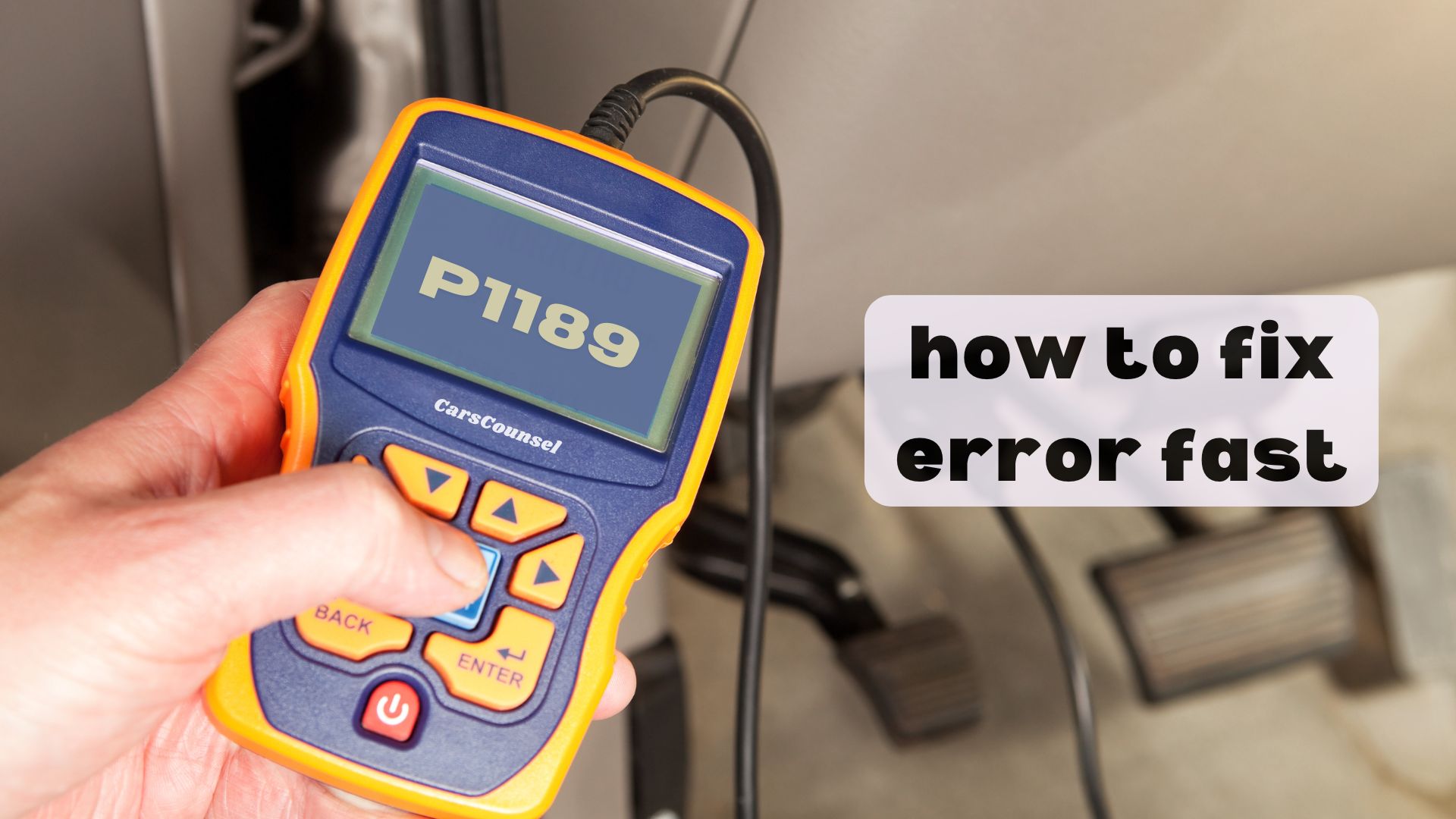When your vehicle’s onboard computer logs a P1189 code, it’s alerting you to a problem with the fuel pressure monitoring system. Specifically, the governor deviation at engine speed is too high, which can lead to poor fuel efficiency, rough idling, and hesitation during acceleration.
You’ll want to investigate this issue promptly to prevent further damage. Start by examining the fuel system components, including sensors, regulators, filters, pumps, and injectors, to identify the faulty part that’s causing the governor to malfunction.

Quick Navigation
Key Takeaways
- P1189 code indicates a problem with the fuel pressure monitoring system, causing poor engine performance and decreased fuel efficiency.
- The code is triggered when the governor deviation occurs at engine speed being too high, affecting fuel pressure and engine performance.
- Faulty sensors, fuel pressure regulator, fuel filter, fuel pump, or fuel injectors may cause the governor deviation, leading to P1189 code.
- Symptoms of P1189 code include decreased fuel efficiency, rough idling, hesitation during acceleration, and an illuminated check engine light.
- To fix P1189 code, inspect and test the fuel system components, replace the faulty part, and clear the diagnostic code.
What Is Code P1189?
When your vehicle’s onboard computer generates a P1189 code, it indicates a problem with the fuel pressure monitoring system, specifically related to governor deviation at engine speed being too high.
This deviation affects engine performance, leading to poor fuel efficiency, rough idling, and hesitation during acceleration. Faulty sensors may be the culprit, causing the fuel pressure governor to malfunction.
As a result, the fuel pressure in the system isn’t regulated properly, leading to potential issues with fuel delivery to the engine. The check engine light will likely illuminate, signaling the need for prompt attention to prevent further damage.
Common Causes of P1189
Faulty components within the fuel pressure monitoring system are the primary culprits behind the P1189 code.
You’ll need to identify the root cause to fix the issue.
Common causes include:
- Faulty fuel pressure regulator, leading to pressure fluctuations and faulty sensor readings
- Clogged fuel filter, restricting fuel flow and causing poor engine performance
- Malfunctioning fuel pump, failing to maintain consistent fuel pressure
These faulty components can disrupt the fuel pressure governor, leading to a deviation at high engine speeds and triggering the P1189 code.
Symptoms of P1189
How will you know if your vehicle is experiencing a P1189 code? Pay attention to these symptoms:
| Symptoms | Description |
|---|---|
| Decreased Fuel Efficiency | You may notice your vehicle is guzzling more gas than usual, which can be costly and environmentally unfriendly. Follow fuel efficiency tips to improve your vehicle’s performance. |
| Rough Idling | If your engine is stuttering or stalling, it could be a sign of a P1189 code. This can be frustrating and affect engine performance optimization. |
| Hesitation During Acceleration | Do you feel like your vehicle is lagging when you hit the gas? This could be related to the P1189 code, which affects fuel delivery to the engine. |
How to Fix P1189
To diagnose and fix the P1189 code, you’ll need to identify the root cause of the fuel pressure deviation at high engine speeds.
This involves fixing faults in the fuel pressure monitoring system, which can be caused by pressure problems in the fuel pump, regulator, or injectors.
To resolve the issue, follow these steps:
- Inspect and test the fuel pressure regulator, fuel filter, fuel pump, and fuel injectors to determine the faulty component.
- Replace the faulty component to resolve the pressure problem.
- Clear the diagnostic code and test drive the vehicle to guarantee the issue has been verified.
Diagnosing the Fuel Pressure Monitoring System
When diagnosing the fuel pressure monitoring system, you’ll need to methodically eliminate potential causes of the P1189 code. Start by performing fuel system checks, including inspecting the fuel filter and fuel injectors for clogs or blockages.
Next, conduct engine performance analysis to identify any deviations in fuel pressure at high engine speeds. Use a scan tool to retrieve trouble codes and monitor fuel pressure readings.
| Fuel System Component | Symptoms of Failure |
|---|---|
| Fuel Filter | Decreased fuel efficiency, rough idling |
| Fuel Injectors | Hesitation during acceleration, engine misfires |
| Fuel Pump | Low fuel pressure, difficulty starting engine |
| Fuel Pressure Regulator | Inconsistent fuel pressure, engine stalling |
| Wiring/Electrical Issues | Intermittent fuel pressure readings, engine codes |
Fuel Pressure Regulator Issues
You’re likely to suspect a faulty fuel pressure regulator if your scan tool reveals inconsistent fuel pressure readings or the engine stalls frequently.
A faulty regulator can cause pressure surges, leading to governor deviation at high engine speeds.
This can result in poor fuel efficiency, rough idling, and hesitation during acceleration.
- Inconsistent fuel pressure readings
- Engine stalling or hesitation
- Pressure surges that exceed the recommended fuel pressure range
Fuel System Component Failure
Fuel system component failure is another common cause of P1189, which can occur when a faulty fuel pump, clogged fuel filter, or malfunctioning fuel injectors disrupt the fuel pressure monitoring system.
You’ll need to inspect these components to identify the root cause. A faulty fuel pump may prevent proper fuel pressure, while a clogged fuel filter can restrict fuel flow. Malfunctioning fuel injectors can also impact fuel delivery.
Additionally, issues with the fuel pump relay or faulty sensors can contribute to the problem. By pinpointing the faulty component, you can replace it and restore proper fuel pressure monitoring system function.
Cost and Additional Information
The cost to repair a P1189 code issue can vary widely, depending on the specific cause of the problem and the cost of parts and labor.
You can expect to pay anywhere from $200 to $500, including parts and labor, for fuel system maintenance and repairs.
Some factors to ponder:
- Labor rates at auto repair shops can vary, so it’s best to get estimates from local shops.
- DIY enthusiasts may be able to save money by replacing the fuel filter, cleaning the fuel injectors, or checking for vacuum leaks.
- Leaving the issue unresolved can lead to further damage to the engine and components, making prompt repair estimates essential.
More OBD-II Codes
| P1187 | P1190 | P1215 | P1216 |
| P1217 | P1218 | P1219 | P1220 |
| P1228 | P1234 | P1237 | P1231 |
| P1240 | P1250 | P1286 | P1287 |
| P1288 | P1305 | P1395 | P1310 |
| P1394 | P1390 | P1396 | P1371 |
Frequently Asked Questions
Can I Drive Safely With the P1189 Code Illuminated?
You shouldn’t drive with the P1189 code illuminated, as poor engine performance monitoring can lead to decreased fuel efficiency, rough idling, and hesitation; consider fuel injector cleaning or replacement to prevent further damage and guarantee safe driving.
Will a Tune-Up Resolve the P1189 Code Issue?
When you’re trying to fix a misfiring engine, it’s like trying to find a specific puzzle piece – it’s all about the right fit. A tune-up won’t resolve the P1189 code issue, as spark plug wear and fuel injector flow aren’t the root causes of this problem.
Can a Faulty Oxygen Sensor Cause a P1189 Code?
You’re wondering if a faulty oxygen sensor can cause a P1189 code. While sensor failure can impact engine performance, it’s unlikely to trigger a P1189 code, which is typically related to fuel leaks or pressure regulator issues, not oxygen sensor malfunctions.
Does the P1189 Code Affect Diesel Engines as Well?
You’re wondering if the P1189 code affects diesel engines too. Yes, it does. Diesel fuel systems require precise pressure regulation for ideal engine performance, and a governor deviation can impact fuel efficiency, idle quality, and overall performance in diesel engines as well.
Will a Fuel System Cleaning Resolve the P1189 Code Issue?
You’re hoping a magic fuel system cleaning wand will fix the issue, but sorry, it won’t; you’ll need to get your hands dirty with a fuel pump inspection and fuel injector diagnosis to identify the root cause, then replace the faulty component.
Conclusion
As you navigate the complex landscape of your vehicle’s fuel system, code P1189 serves as a warning sentinel, signaling a deviation in the governor’s rhythm. Like a conductor out of sync, the fuel pressure monitoring system falters, disrupting the harmony of engine performance. Heed the warning, and don’t let the malfunctioning component orchestrate a symphony of problems. Identify and replace the faulty part to restore balance, ensuring a smooth ride and preventing further damage.

